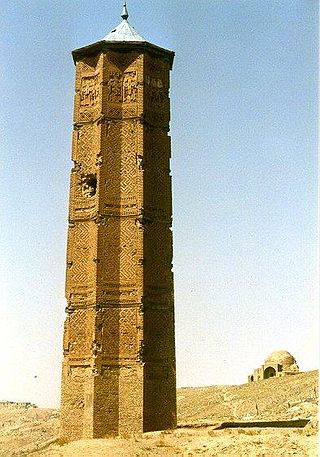
Ahmad Senjer (Persian: احمد سنجر; full name: Muizz ad-Dunya wa ad-Din Adud ad-Dawlah Abul-Harith Ahmad Sanjar ibn Malik-Shah) (b. 1085 – d. 8 May 1157) was the Seljuq ruler of Khorasan from 1097 until in 1118, when he became the Sultan of the Seljuq Empire, which he ruled until his death in 1157.
Altuntash was a Turkic Khwarazmshah from 1017 until his death in 1032.

Chaghaniyan, known as al-Saghaniyan in Arabic sources, was a medieval region and principality located on the right bank of the Oxus River, to the south of Samarkand.

Abu Ali Ahmad Chaghani was the Muhtajid ruler of Chaghaniyan (939–955) and governor of Samanid Khurasan. He was the son of Abu Bakr Muhammad.

The Afrighids were a native Khwarezmian Iranian dynasty who ruled over the ancient kingdom of Khwarezm. Over time, they were under the suzerainty of the Sasanian Empire, the Hephthalite Empire, the Göktürk Khaganate, the Umayyad Caliphate, Abbasid Caliphate and the Samanid Empire.

Guzgan was a historical region and early medieval principality in what is now northern Afghanistan.

Transoxiana or Transoxania is the Latin name for a region and civilization located in lower Central Asia roughly corresponding to modern-day eastern Uzbekistan, western Tajikistan, parts of southern Kazakhstan, parts of Turkmenistan and southern Kyrgyzstan. Geographically, it is the region between the rivers Amu Darya to its south and the Syr Darya to its north.

Muhammad ibn Rustam Dushmanziyar, also known by his laqab of Ala al-Dawla Muhammad, was a Daylamite military commander who founded in 1008 the short-lived but important independent Kakuyid dynasty in Jibal. He is also known as Pusar-i Kaku, Ibn Kakuyeh, Ibn Kakuya, and Ibn Kaku, which means maternal uncle in the Deylami language, and is related to the Persian word "kaka". Muhammad died in September 1041 after having carved out a powerful kingdom which included western Persia and Jibal. However, these gains were quickly lost under his successors.
Abuʾl-Ḥasan al-Qāsim Aḥmad ibn Ḥasan Maymandī, better known as Ahmad Maymandi, and also known by his honorific title of Shams al-Kufat, was a Persian vizier of the Ghaznavid ruler Mahmud of Ghazni and the latter's son Mas'ud I of Ghazni.
The Bukhar Khudahs or Bukhar Khudats were a local Sogdian dynasty, which ruled the city of Bukhara from an unknown date to the reign of the Samanid ruler Isma'il ibn Ahmad, who incorporated Bukhara into the Samanid state.

The Principality of Chaghaniyan, known in Arabic sources as al-Saghaniyan, was a part of the Hephthalite Confederation from the 5th to the 7th century CE. After this, it was ruled by a local, presumably Iranian dynasty, which governed the Chaghaniyan region from the late 7th-century to the early 8th-century CE. These rulers were known by their titles of “Chaghan Khudah”.

Ali ibn Hasan, also known as Harun Bughra Khan and better known as Ali-Tegin was a Karakhanid ruler in Transoxiana from 1020 to 1034 with a brief interruption in 1024/25.

Harev, was a Sasanian province in Late Antiquity, that lay within the kust of Khorasan. The province bordered Kushanshahr in the west, Abarshahr in the east, Marv in the north, and Sakastan in the south.
Abu Ishaq Ibrahim, also known as Ishaq ibn Alp-Tegin, was a Turkic officer, who was the Samanid governor of Ghazna from September 963 to November 966. He was the son and successor of Alp-Tegin.
Khwaja Abu Nasr Ahmad, better known as Ahmad Shirazi, also known as Ahmad(-e) Abd al-Samad, was a Persian vizier of the Ghaznavid Sultan Mas'ud I and the latter's son Mawdud from 1032 to 1043. He was the son of the Samanid secretary Abu Tahir Shirazi, and had a son named Abd al-Hamid Shirazi, who would also later serve as vizier. He was originally from the city of Shiraz.

Ghazni is a city in southeastern Afghanistan, which served as the capital of the Ghaznavid Empire from 977 to 1163.

Bilgetegin was a Turkic officer, who was the Samanid governor of Ghazna from 12 November 966 to 975. He was successor of Abu Ishaq Ibrahim of Ghazna.
Tughshada was Bukhar Khudah from 681 to 739. He was the son and successor of Bindu.
Shams al-Mulk Nasr was a Karakhanid ruler in Transoxiana from 1068 to 1080. He was one of the greatest rulers of the dynasty.











